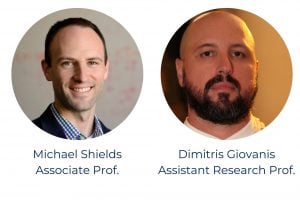
Michael Shields, associate professor in the Department of Civil and Systems Engineering, and Dimitris Giovanis, assistant research professor in the same department, are establishing practices for uncertainty quantification in hazards modeling through the renewal of the National Science Foundation’s Natural Hazards Engineering Research Infrastructure Computational Modeling and Simulation Center (SimCenter).
The renewal award provides $12.75M over the next four years to develop and promote advanced modeling and simulation technologies for natural hazards engineering researchers and practitioners to understand and quantify the effects of earthquakes, hurricanes, tsunamis, and other natural hazards on buildings, lifelines, and communities.
 “We’re excited to join the SimCenter team and use our expertise in uncertainty quantification (UQ) and machine learning to aid in software development tasks related to UQ/ML in SimCenter software tools,” said Shields. “In practice, this means that we will be working with SimCenter postdocs to oversee the development and implementation of UQ methods in their various software packages, including integration of the UQpy software that my group develops with the quoFEM package developed in the SimCenter.”
“We’re excited to join the SimCenter team and use our expertise in uncertainty quantification (UQ) and machine learning to aid in software development tasks related to UQ/ML in SimCenter software tools,” said Shields. “In practice, this means that we will be working with SimCenter postdocs to oversee the development and implementation of UQ methods in their various software packages, including integration of the UQpy software that my group develops with the quoFEM package developed in the SimCenter.”
To date, the SimCenter has published six user-facing software applications with an emphasis on uncertainty quantification, high-performance computing capability, and direct applications to current research needs, including CFD, turbulence inflow, performance-based engineering, hydrodynamic loading, earthquake engineering, and regional simulation capabilities that incorporate examples derived from a collection of testbeds. SimCenter tools have created broadly integrative capabilities for natural hazards engineers that greatly exceed those of prior efforts. A complementary education and outreach program with educational applications, webinars, workshops, and software training sessions have informed and educated its engaged community.
The renewal of the SimCenter builds upon the existing framework with integrative tools for hazard modelers, efforts for enhancing detailed modeling, expansion of regional capabilities to include new hazards and interfaces with urban planning and modeling tools. At the heart of these developments will be the availability of the latest uncertainty quantification methods. A continued focus on education will expand on previous activities with modules to support classroom instruction and hackathon events. These are offered in addition to support and training for researchers to adapt SimCenter products to the particular need of their research.
JHU is an educational affiliate of the Pacific Engineering Research Center, lead organization on the SimCenter, a relationship previously established by Prof. Ben Schafer. According to Schafer, “NSF’s SimCenter is a national leader in hazards research, particularly with respect to wrapping our arms around the impact of uncertainty in natural hazards risks for our infrastructure. The fact that CaSE’s own Michael Shields and Dimitris Giovanis are part of the team shows how broadly our work in these areas is embraced.”